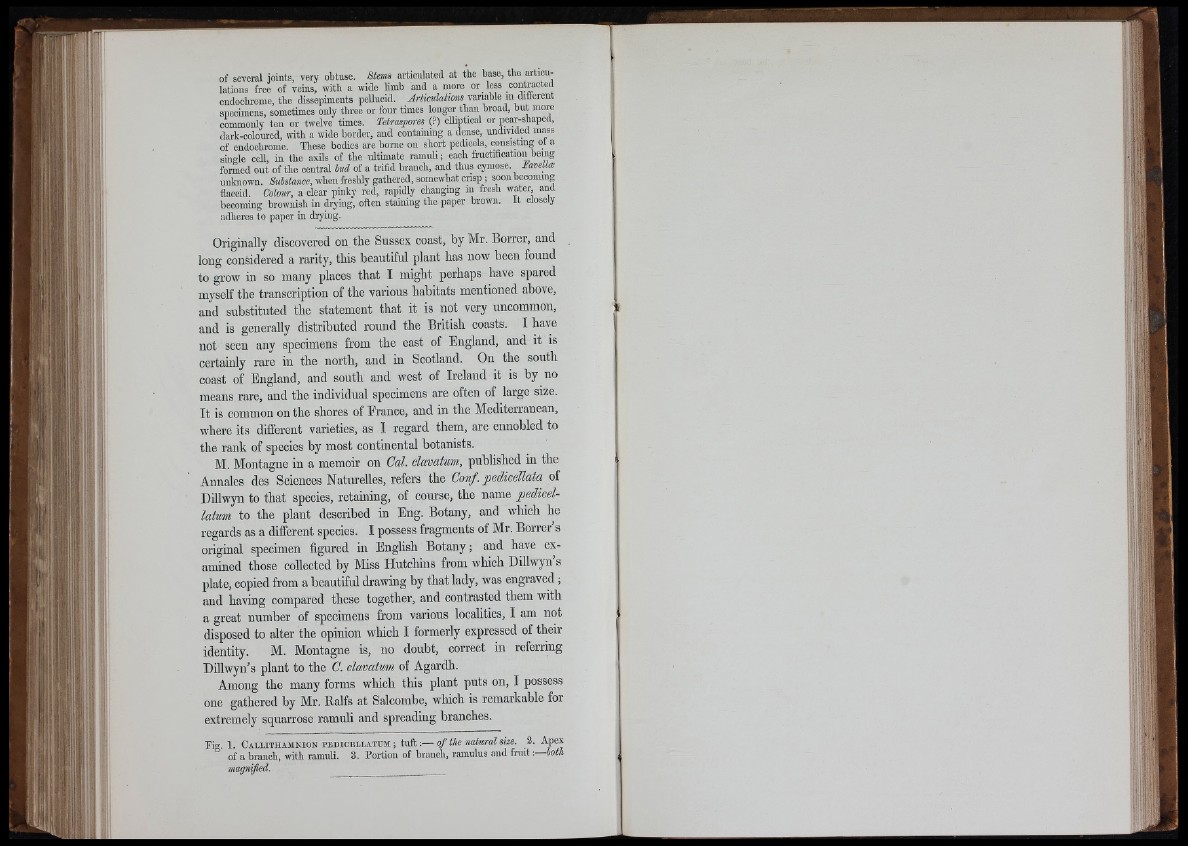
of several ioints, very obtuse. S tm s articulated at the base, the “rticu-
lations free of veins, with a wide hmb and a more or less contracted
endochrome, the dissepiments pellucid. variable in difierent
specimens, sometimes only thi-ee or four times longer tlian broad, but more
commonly ten or twelve times. Tetraspores (?) eUiptical or pear^-shaped,
dark-coloured, with a wide border, and containing a dense, undivided mass
of endochrome. These bodies are borne on short pedicels, consisting qt a
single cell, in the axUs of the ultimate ramuli; each fructification being
forSied out of the central bad of a trifid branch, and thus cymose. FaveUæ
unknown. Substame, when freshly gathered, somewhat crisp ; soon becoming
flaccid. Colour, a clear pinky red, rapidly changing in fresh water and
becoming brownish in drying, often stammg the paper brown, i t closely
adheres to paper in drying.
Originally discovered on the Sussex coast, hy Mr. Borrer, and
long considered a rarity, this beautiful plant has now been found
to grow in so many places that I might perhaps have spared
myself the transcription of the various habitats mentioned above,
and substituted the statement that it is not very uncommon,
and is generally distributed round the British coasts. I have
not seen any specimens from the east of England, and it is
certainly rare in the north, and in Scotland. On the south
coast of England, and south and west of Ireland it is by no
means rare, and the individual specimens are often of large size.
It is common on the shores of Erance, and in the Mediterranean,
where its different varieties, as I regard them, are ennobled to
the rank of species by most continental botanists.
M. Montagne in a memoir on Cal. clavatum, published in the
Annales des Sciences Natiuelles, refers the Conf. pedicellata of
Dillwyn to that species, retaining, of course, the name pedicellatum
to the plant described in Eng. Botany, and which he
regards as a different species. I possess fragments of Mr. Borrer s
original specimen figured in English Botany ; and have examined
those collected by Miss Hutchins from which Dillwyn’s
plate, copied from a beautiful drawing by that lady, was engraved ;
and having compared these together, and contrasted them with
a great number of specimens from various localities, I am not
disposed to alter the opinion which I formerly expressed of their
identity. M. Montagne is, no doubt, correct in referring
Dillwyn’s plant to the C. clavatum of Agardh.
Among the many forms which this plant puts on, I possess
one gathered by Mr. Ralfs at Salcombe, which is remarkable for
extremely squarrose ramuli and spreading branches.
Fig. 1. Ca l l it h a m n io n p e m c e l l a t c m ; Udi-.— of the natural size. 2. Apex
of a branch, with ramuli. 3. Portion of branch, ramulus and fnut -.— both
ri i'
r i l l
:ri
ft i'i
7 i l l
" Mi